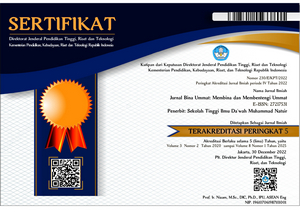TEKNIK KOMUNIKASI PERSUASIF MUHAMMAD HUSEIN MELALUI YOUTUBE DALAM MEMBANGUN KESADARAN BERDONASI
DOI:
https://doi.org/10.38214/jurnaldawahstidnatsir.v8i1.327Keywords:
Persuasive Communication Techniques, YouTube, Donation AwarenessAbstract
Tujuan Penelitian: Untuk mendeskripsikan teknik komunikasi persuasif Muhammad Husein melalui Youtube dalam membangun kesadaran berdonasi. Metode Penelitian: Kualitatif. Hasil Penelitian: Hasil penelitian menunjukan teknik komunikasi persuasif Muhammad Husein menggunakan empat dari lima teknik komunikasi persuasif menurut teori Onong Uchjana Effendy, yaitu: Pertama, teknik asosiasi dengan mengaitkan pesan kepada tokoh penting untuk membangun kredibilitas. Kedua, melalui penggunaan kata “kita” untuk menumbuhkan solidaritas emosional. Ketiga, teknik ganjaran, baik pay-off berupa transparansi donasi maupun fear arousing melalui visualisasi kondisi Gaza. Keempat, teknik tataan (icing) dengan penyusunan pesan verbal dan deskripsi video yang menggugah emosi. Kesimpulan: Muhammad Husein melalui Youtube-nya dalam membangun kesadaran berdonasi menggunakan empat teknik komunikasi persuasif yaitu: teknik asosiasi, teknik integrasi, teknik ganjaran dan teknik tataan.
Downloads
Published
How to Cite
Issue
Section
License
Copyright (c) 2025 Jurnal Da'wah: Risalah Merintis, Da'wah Melanjutkan

This work is licensed under a Creative Commons Attribution 4.0 International License.
This work is licensed under a Lisensi Creative Commons Atribusi 4.0 Internasional.
Authors who publish with this journal agree to the following terms:
- Authors retain copyright and grant the journal right of first publication with the work simultaneously licensed under a Creative Commons Attribution License that allows others to share the work with an acknowledgment of the work's authorship and initial publication in this journal.
- Authors are able to enter into separate, additional contractual arrangements for the non-exclusive distribution of the journal's published version of the work (e.g., post it to an institutional repository or publish it in a book), with an acknowledgment of its initial publication in this journal.
- Authors are permitted and encouraged to post their work online (e.g., in institutional repositories or on their website) prior to and during the submission process, as it can lead to productive exchanges, as well as earlier and greater citation of published work (See The Effect of Open Access).



